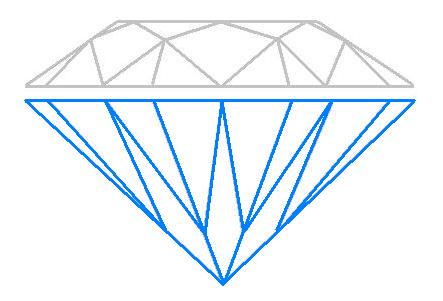The pavilion depth percentage is a crucial measurement in understanding how well a diamond performs in terms of brilliance and light reflection. It refers to the pavilion depth (the vertical distance from the girdle to the culet) expressed as a percentage of the diameter of the diamond. This proportional measurement plays a significant role in determining how light interacts with the diamond, and its effect on the diamond’s aesthetic appearance and overall quality.
What is Pavilion Depth Percentage?
Pavilion depth percentage is the ratio of the pavilion depth to the diameter of the diamond, calculated as a percentage.
For example, if the pavilion depth is 43% of the total diameter of the diamond, this means that the pavilion depth makes up 43% of the total horizontal width of the diamond.
The percentage is important because it gives an indication of how well the diamond is proportioned. Proper pavilion depth percentage ensures that the diamond maximizes its light performance and visual appeal, contributing to its brilliance and fire.
How Pavilion Depth Percentage Affects Diamond Light Performance
1. Brilliance and Sparkle
The pavilion depth percentage affects how light is reflected inside the diamond. When light enters the diamond, it bounces off the pavilion facets, refracting and dispersing through the crown (the top part of the diamond) and exiting through the table (the flat top surface).
A well-proportioned pavilion depth percentage ensures that light is optimally reflected and refracted, which maximizes the brilliance and sparkle of the diamond. This is the characteristic that gives a diamond its signature fire and life.
2. Nailhead Effect (Too Deep Pavilion)
When the pavilion depth percentage is too high, the diamond’s pavilion becomes too deep, leading to a phenomenon known as the nailhead.
The nailhead occurs when light is trapped inside the pavilion, failing to reflect out of the diamond’s crown, resulting in a dark appearance. This effect can significantly reduce the diamond’s brilliance and visual appeal.
In other words, a too deep pavilion leads to a lack of light return, causing the diamond to look dull and lacking in sparkle.
3. Fish Eye Effect (Too Shallow Pavilion)
On the flip side, when the pavilion depth percentage is too shallow (i.e., the pavilion is too flat), a fish eye effect can occur.
The fish eye is caused by light entering the diamond and reflecting off the flat pavilion in such a way that it creates an unattractive, dark circle near the center of the diamond. The diamond looks flat and lifeless, with reduced sparkle.
A shallow pavilion prevents light from being properly reflected inside the diamond, causing it to appear less vibrant and lacking in brilliance.
Ideal Pavilion Depth Percentage for Round Brilliant Diamonds
For round brilliant cut diamonds, the ideal pavilion depth percentage typically falls within the range of 43% to 44% of the diamond’s diameter.
This range allows for optimal light reflection and refraction, ensuring the diamond achieves maximum brilliance and fire. Within this range, the diamond will appear vibrant and full of life, with a balanced distribution of light and sparkle.
Impact of Pavilion Depth Percentage on Diamond Value
1. Light Performance and Value
Diamonds with properly proportioned pavilion depth percentages are considered to have higher light performance, which enhances their brilliance and fire. As a result, these diamonds are more valuable and sought after by buyers.
Diamonds with poor pavilion depth percentages (either too deep or too shallow) tend to have lower brilliance and reduced visual appeal, which can decrease their market value.
2. Cut Grade and Market Appeal
The pavilion depth percentage is an integral component of the cut grade of a diamond. A diamond with a well-proportioned pavilion typically receives a higher cut grade, which directly impacts its market price.
Buyers often prioritize diamonds with well-proportioned cuts, as they promise a more aesthetic and eye-catching appearance. As a result, diamonds with the right pavilion depth percentage are more likely to command a premium price in the market.
How to Measure Pavilion Depth Percentage
1. Grading Reports
Reputable gemological laboratories like the Gemological Institute of America (GIA) and the Diamond Certification Laboratory of Australia (DCLA) provide detailed grading reports for diamonds, including the pavilion depth percentage.
These reports include measurements for the pavilion depth, total depth, and diameter of the diamond, which allow buyers and gemologists to calculate the pavilion depth percentage accurately.
2. Manual Measurement
A certified gemologist can also measure the pavilion depth percentage manually using specialized tools like a microscope or digital calipers. However, this measurement is typically included in certified grading reports, ensuring accuracy and consistency.

